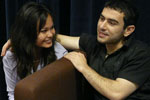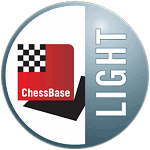
World Championship 2007 Mexico
The World Championship 2007 will take place from September 12 to 30 in the
Sheraton Centro Histórico Hotel in Mexico City. Eight players are qualified
– the tournament will be a double round robin. The prize fund is US $1.3
million.
Round nine commentary by GM Mihail Marin
Leko-Svidler featured a relatively short but intense fight, which led to an
approximately equal ending and a draw agreement. Playing with white, Grischuk
obtained a minimal but persistent advantage against Gelfand. Just when he was
close to a draw, Gelfand's nerves cracked under the pressure and Grischuk took
the whole point without any difficulties. Anand employed another rare line against
Aronian's Marshall Attack, but the experiment did not work too well this time
and a draw was agreed rather soon.
The most remarkable game of the evening was Morozevich-Kramnik. After an opening
that is supposed to offer Black an easy life, play transposed to a curious version
of the Benoni. Morozevich adjusted his plan to the specific characteristics
of the position perfectly, while the World Champion offered a surprisingly feeble
resistence. Mass simplifications only increased White's advantage and Morozevich
won convincingly.
Leko,P (2751) - Svidler,P (2735) [B90]
WCh Mexico City MEX (9), 23.09.2007 [Mihail Marin]
1.e4 c5. Fashion is cruel. Just a few years ago, about half of the
games played at high level started with these moves. In Mexico, the first Sicilian
was played in the second half of the tournament... 2.Nf3 d6 3.d4 cxd4 4.Nxd4
Nf6 5.Nc3 a6 6.Be3 e5 7.Nb3 Be6 8.Qd2 Nbd7 9.f3 Be7 10.g4 0-0 11.0-0-0 b5
12.Rg1!? This ultra-refined move was first played by Anand against Morozevich,
in Monaco 2006. Morozevich won the game with Black, but was apparently impressed
by the idea and employed it himself in the same tournament, and... lost, too!
White is not in a hurry to advance his g-pawn, because after 12.g5 b4! 13.Nd5
Black can preserve his light-squared bishop with 13...Nxd5 14.exd5 Bf5 . At the
same time, the presence of the rook on the g-file is generally useful.
12...Nb6.
Now, after 12...b4 13.Nd5 Black would have to give up his bishop, when a
further g5 will open the important h3-c8 diagonal for the white king's bishop.
13.Na5 Rc8 14.g5 Ne8 15.a3 Qc7 16.Kb1 d5! 17.exd5 Nxd5 18.Nxd5 Bxd5
19.Bh3. White completes his development and attacks two enemy pieces
at the same time. The immediate 19.Qxd5? was impossible because of 19...Rd8.
19...Be6!? An interesting decision. After 19...Rd8 20.Qf2 , the pressure
of White's bishop would have been irritating. 20.Bxe6 fxe6. Black's structure
does not look too impressive now, but the open f-file as well as the absence
of a blocking knight on e4 make the situation unclear. 21.Qd7!? A courageous
move, which, after Black's cautious answer, will only lead to simplifications.
21...Qxd7. Svidler was probably afraid that after 21...Qxc2+ 22.Ka2
his pieces would lose coordination. Indeed, after 22...Rc3 Black can parry the
threat ...Rxa3+ followed by mate with 23.Qxe7 ,when Black's attacking prospects
remain debatable, mainly because of his passive knight. 22.Rxd7 Rc7 23.Rxe7
Rxe7 24.Bc5 Ref7 25.Bxf8 Kxf8 26.Nc6 Rxf3 27.Nxe5 Rf5 28.Nd3 a5 29.h4 1/2-1/2.
[Click to replay]

Peter Svidler and Peter Leko in the post-game press conference

You really think so? You really believe that?
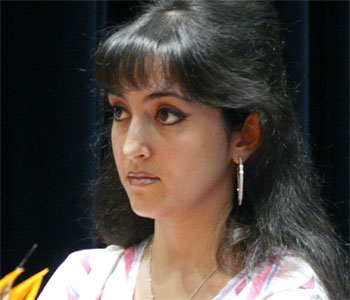
Peter's wife and moral support: Sofi Leko
Grischuk,A (2726) - Gelfand,B (2733) [E21]
WCh Mexico City MEX (9), 23.09.2007 [Mihail Marin]
1.d4. Earlier in this tournament, Gelfand has successfully defended
Black's point of view in the Petroff three times already. Grischuk wisely decided
to change the background. 1...Nf6 2.c4 e6 3.Nc3 Bb4 4.Nf3 c5 5.g3 cxd4 6.Nxd4
0-0 7.Bg2 d5 8.cxd5 Nxd5 9.Qb3 Qa5 10.Bd2 Nc6 11.Nxc6 bxc6 12.0-0 Bxc3 13.bxc3
Ba6 14.Rfd1 Qc5 15.e4 Bc4 16.Qa4 Nb6 17.Qb4 Qh5 18.Bf4
The position is very slightly more pleasant for White, but most of the games in
which this variation was played ended in draws. Black has a normal development,
but experiences some micro-problems. Now, he needs to establish some communication
between his queen and the rest of the pieces.
18...Be2 19.Re1 c5 20.Qb3 e5
21.Bc1 Rac8 22.a4 Bc4 23.Qb2 Qg6 24.a5 Nd7 25.Rd1 Qc6 The queen is back in
the game, but in the meanwhile the knight has occupied an unfavourable square.
We can state that Black's micro-problems persist.
26.Bh3 Be6 27.Bxe6 Qxe6 28.Be3
Rc7 29.Qa2 Qxa2 30.Rxa2 Nf6 31.f3 Rfc8. 31...Rb8 would not have prevented
32.Rb2! anyway.
32.Rb2
The knight has reached a stable square, but White maintains the better prospects
because of his control over both open files. By contrast,Black's rooks are doubled
behind the own c-pawn.
32...Kf8 33.Kf2 Ke7 34.Bg5 h6 35.Bxf6+ Kxf6 36.Rd6+
Ke7 37.Rd5 f6 38.Ke3 g5 39.c4 Rc6 40.Rb5 Ke6 41.f4. In order to increase his
advantage, White needs to open a new front of action.
41...R6c7 42.Kf3 h5.
Preventing the king's infiltration to h5, but weakening his own kingside structure.
43.Ke3 gxf4+. At first sight, this looks like a premature release of the
tension, but Gelfand probably hoped for some kingside counterplay at some moment.
44.gxf4 h4 45.f5+ Kf7 46.Kf3 Kg7 47.Rb1 Kh6 48.Rd6 Rc6 49.Re6 [49.Rd2!?]
49...Rxe6 50.fxe6 Re8 51.Rb7 Rxe6 52.Rxa7 Rd6 53.a6
53...h3? 53...Kg5 54.Rg7+ Kh6 55.a7 Ra6 56.Rb7 Kg5. 54.Kg4 Rd3 55.Ra8
Kg7 56.Kf5 Rd6 57.Ra7+ Kh6 58.Rf7 Offering a simplification to a won pawn
ending. 58...Rd2 59.a7 Rf2+ 60.Ke6 Ra2 61.Kxf6. Black is paralyzed and
will lose most of his pawns. 1-0. [Click
to replay]
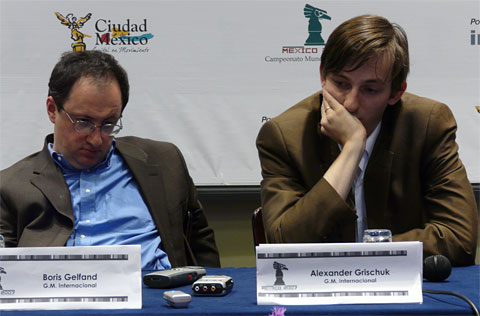
The players in the press conference after their game

Devastated: Boris Gelfand after his first loss, in round nine
Anand,V (2792) - Aronian,L (2750) [C89]
WCh Mexico City MEX (9), 23.09.2007 [Mihail Marin]
1.e4 e5 2.Nf3 Nc6 3.Bb5 a6 4.Ba4 Nf6 5.0-0 Be7 6.Re1 b5 7.Bb3 0-0 8.c3
d5 9.exd5 Nxd5 10.Nxe5 Nxe5 11.Rxe5 c6 12.d4 Bd6
13.Re2. We can notice that for each game Anand prepares a different
variation against the Marshall. This might look like a speculative attitude,
but maybe there is no other way to counter such a well-analyzed opening. 13...Bg4
14.f3 Bf5 15.g3. Earlier, White played 15.Bxd5 mainly. The idea behind
Anand's novelty remains unclear, especially that the game will end soon. 15...Qc7
16.Kf2 Qd7 17.Bxd5 cxd5 18.Nd2 Bd3 19.Re3 Bg6 20.Nf1 a5 21.a3. Black has
the usual compensation, based on his pair of bishops and more active position.
1/2-1/2. [Click to replay]

Vishy Anand in the press conference

Lev Aronian being interviewed by Russian TV and radio journalist Elmira Mirzoeva

Friendly support: Aronian's girlfriend Arianne Caoili and second Gabriel Sargissian
Morozevich,A (2758) - Kramnik,V (2769) [A34]
WCh Mexico City MEX (9), 23.09.2007 [Mihail Marin]
1.c4 c5 2.Nc3 g6 3.e3 Bg7 4.d4 Nf6
Apparently, White has played the opening without any ambition.
5.d5!? But
this move causes an opposite impression.
5...0-0 6.Nf3 e6 7.Be2 exd5 8.cxd5
d6
As an experienced Benoni player, I have problems finding a proper name to this
almost non-existent variation; "the e3-Benoni" sounds almost comical! However,
White's setup is not without venom. By refraining from exposing his e-pawn to
early attacks (...Re8), White intends to obtain more freedom of action for his
minor pieces. His king's knight could go to c2 (via e1) in order to counter
a later ...b5 with b4, or to the more usual c4-square, without having to care
about defending the e4-pawn from d2. We shall see further differences as the
game advances. One possible drawback of this system is that the c1-bishop will
remain passive for a long time. From psychologic point of view, Morozevich choice
is simply brilliant. Kramnik does not play this opening regularly (although
he employed it in the penultimate game of his match against Leko, when he desperately
needed to win) and, almost surely, never studied the e3-system! There are not
many recent cases when the World Champion was taken "out of book" at such an
early stage, with the position remaining cmplex at the same time.
9.0-0 Bg4 10.h3 Bxf3 11.Bxf3 Nbd7 12.a4 a6 13.g4!? This original attempt
to win space will be fully crowned by success. 13...c4?! This is a typical
move in the Benoni, but maybe the prophylactic 13...h6!? should have been preferred
here. 14.Be2! Rc8 With the pawn on e4, Black could answer 14...Nc5 15.f3
Rc8. 15.g5 Ne8 16.f4. Now, the c1-bishop proves useful by safely defending
the backward pawn. 16...Qe7 17.Ra3 Rc5. Kramnik's play in this phase
of the game is not too logical. He starts queenside operations with his knight
and king's rook passive on the other wing. Personally, I would first think of
eliminating the g5-pawn with 17...h6 18.h4 f6 when 19.Bg4 , threatening to invade
the e6-square, can be answered with 19...Nc7. 18.Bf3 Ra5 19.Bd2 Nc5 20.Qe2
Nb3
21.Ne4. We can see that White makes use of the e4-square to activate
his knight. Now, ...f6 is out of question already, because of gxf6 followed
by Ng5-e6. 21...Nxd2 22.Qxd2. After the exchange of his queen's bishop,
White has solved all his problems with the development. Black's control on dark
squares is less relevant than in a normal Benoni, because the d4-square has
not been weakened with e4 yet. White has a clear and stable advantage. 22...Qd8
23.Qb4 b5 24.axb5 Rxb5 25.Qxc4 Qb6 26.Qc6 Bxb2 27.Qxb6 Rxb6 28.Ra2 Bg7 29.Rc1
h6 30.h4 hxg5 31.hxg5 f6 32.Rc6 Rxc6 33.dxc6 fxg5 34.Nxg5 Nc7
Despite simplifications, Black has a difficult position. White has an enormous
advantage of space and his c6-pawn is very dangerous. 35.Rd2 Rd8 36.Bg4 Bc3
37.Rd3 Ba5 38.Kg2 d5 39.e4. It was worth waiting with this move for so long.
The advance of the e-pawn will increase White's advantage. 39...d4 40.e5
Bb6 41.Rb3 Rb8 42.Rh3 Ba5 43.Rh6 Rb2+ 44.Kg3 Be1+ 45.Kf3 d3 46.Rxg6+ Kf8 47.Rd6
d2 48.Ke4 1-0. [Click to replay]
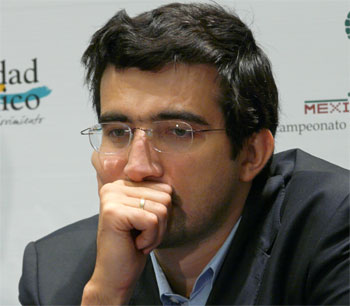
Vladimir Kramnik, contemplating his first defeat in this event

Alexander Morozevich, who avenged his first-half loss to Kramnik
Photos by Frederic Friedel in Mexico City
All results of the round
| Round 9: Sunday, Sept. 23th 2007, 14:00h |
| Peter Leko |
½-½ |
Peter Svidler |
Alexander Grischuk |
1-0 |
Boris Gelfand |
Viswanathan Anand |
½-½ |
Levon Aronian |
Alexander Morozevich |
1-0 |
Vladimir Kramnik |
| |
Current standings

Links
